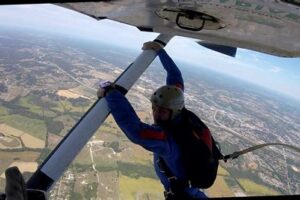Table of Contents
Terminal velocity is the maximum speed a skydiver can reach during freefall due to air resistance. This thrilling experience occurs when the force of gravity pulling the skydiver downwards is balanced by the upward force of air resistance. Understanding terminal velocity is crucial for skydivers as it determines the duration and intensity of their exhilarating freefall. Discover the physics behind this phenomenon and the factors that influence terminal velocity in this captivating adventure through the skies.
Terminal velocity is a fascinating phenomenon that holds both thrill-seekers and scientists in awe. As skydivers plunge towards the earth, their bodies hurtling through the open sky, they reach a point where gravity’s pull is balanced by air resistance. This delicate equilibrium creates a mesmerizing display of physics at work, as the diver enters a state of freefall where their velocity remains constant. With each passing second, the anticipation builds, the adrenaline surges, and the human body becomes an instrument of exploration, defying the boundaries of what we once believed possible.
Introduction
Skydiving is an exhilarating activity that allows individuals to experience the thrill of freefalling through the sky. As one jumps out of a plane, they quickly accelerate due to gravity. However, as they gain speed, they eventually reach a point where they can no longer accelerate further. This maximum speed, known as terminal velocity, plays a crucial role in ensuring the safety and enjoyment of skydivers. In this article, we will explore what terminal velocity is, how it is achieved during skydiving, and why it is an important concept for every skydiver to understand.
The Concept of Terminal Velocity
Terminal velocity is the highest speed an object can attain when falling through a fluid, such as air, without any additional acceleration. It is reached when the gravitational force pulling the object downward is balanced by the drag force acting in the opposite direction. At this point, the forces on the object are in equilibrium, resulting in a constant velocity.
Forces Acting During Skydiving
During a skydive, several forces come into play. The main force is gravity, which pulls the skydiver downward towards the Earth. As the skydiver gains speed, another force called drag comes into effect. Drag is caused by the resistance of the air against the moving body. At lower speeds, drag is relatively small. However, as the speed increases, so does the drag force until it eventually equals the force of gravity.
Factors Affecting Terminal Velocity
Several factors influence the terminal velocity of a skydiver. One of the most significant factors is the skydiver’s body position. When a skydiver assumes a belly-to-earth position, they present a larger surface area to the oncoming air, increasing the drag force. Conversely, adopting a more streamlined position, such as a head-down or delta position, reduces the surface area and thus decreases the drag force acting on the body.
Skydiver Body Positions
Belly-to-earth, head-down, and delta are three common body positions used by skydivers. Each position affects the amount of drag and, consequently, the terminal velocity experienced during freefall.
Calculating Terminal Velocity
Terminal velocity can be calculated using a simple formula that takes into account the weight of the object and the drag coefficient, which depends on the object’s shape and surface characteristics. By equating the gravitational force with the drag force, the equation can be solved to find the terminal velocity.
The Formula for Terminal Velocity Calculation
The formula to calculate terminal velocity is V = sqrt((2 * m * g) / (ρ * A * Cd)), where V represents the terminal velocity, m is the mass of the skydiver, g is the acceleration due to gravity, ρ is the density of the fluid (air), A is the cross-sectional area, and Cd is the drag coefficient.
Importance in Skydiving
Understanding terminal velocity is crucial for skydivers as it helps them maintain control and stability during freefall. By being aware of the factors that affect terminal velocity, such as body position and drag, skydivers can make adjustments to achieve their desired speed and performance in the air. Additionally, knowing the concept of terminal velocity allows skydivers to anticipate how quickly they will reach the ground and plan their parachute deployment accordingly.
Parachute Deployment
Knowing the approximate time it takes to reach terminal velocity enables skydivers to time their parachute deployment effectively. Deploying the parachute too early or too late can have serious consequences, so understanding terminal velocity is essential for a safe skydiving experience.
Safety Measures and Regulations
Given the importance of terminal velocity in skydiving, safety measures and regulations are in place to ensure the well-being of all skydivers. Training programs teach individuals how to control their body position, make accurate calculations, and assess various factors that influence terminal velocity. Furthermore, equipment inspections, weight restrictions, and altitude limits are enforced to mitigate potential risks associated with reaching terminal velocity.
Safety Equipment
Properly maintained safety equipment, including parachutes, altimeters, and helmets, is essential for skydivers to ensure a safe experience. Regular inspections and adherence to manufacturer guidelines are crucial to prevent any equipment-related issues that could impact terminal velocity.
Conclusion
Terminal velocity is a fundamental concept in the world of skydiving. It determines the maximum speed a skydiver can achieve during freefall and plays a vital role in maintaining stability and control. By understanding the factors affecting terminal velocity and adhering to safety measures, skydivers can enjoy this thrilling activity while ensuring their well-being. So, whether you are an experienced skydiver or considering trying it for the first time, having a solid grasp of terminal velocity will enhance your overall skydiving experience.
Understanding Terminal Velocity
Terminal velocity refers to the maximum constant speed an object can reach while freefalling due to the opposing forces of gravity and air resistance. During skydiving, once the skydiver reaches this speed, there is no further acceleration as the forces are balanced. Understanding terminal velocity is crucial for skydivers to ensure a safe and controlled descent.
Factors Influencing Terminal Velocity
Several factors impact terminal velocity during a skydiving descent. Firstly, the weight and size of the skydiver play a significant role – a heavier individual will fall faster due to increased gravitational force. The shape and orientation of the skydiver’s body also affect the amount of air resistance they experience, with a spread-out posture reducing their descent speed.
Calculating Terminal Velocity
Terminal velocity can be determined by considering the balance between drag forces due to air resistance and the force of gravity acting on the skydiver. By employing the drag equation, which incorporates variables such as body surface area and air density, one can calculate the approximate terminal velocity experienced during a skydive. This calculation aids skydivers and professionals in planning the descent and ensuring appropriate landing conditions.
Equipment and Safety Measures
To minimize risks and ensure safe skydiving experiences, proper equipment is essential. Skydivers utilize specialized parachutes and harnesses designed for effective control during descent. Additionally, thorough training programs and safety measures are employed to equip skydivers with the skills and knowledge required to handle terminal velocity and emergency situations.
Varying Terminal Velocities
Terminal velocity can vary depending on various factors, including altitude, atmospheric conditions, and the skydiver’s body position. Higher altitudes provide more time for a skydiver to accelerate before reaching terminal velocity. Conversely, denser air at lower altitudes can increase air resistance, reducing the maximum achievable speed. Skydivers trained in different body positions can alter their terminal velocity for specific purposes, such as formation diving or canopy control.
Risks and Challenges
While skydiving is a thrilling and exhilarating activity, understanding the risks associated with terminal velocity is crucial. Rapid changes in velocity, such as when exiting an aircraft, can introduce sudden forces on the body that require appropriate stability and preparation. Moreover, unexpected weather conditions or parachute malfunctions are variables that skydivers must be trained to handle safely.
Potential Impacts on the Body
Reaching terminal velocity during a skydive can subject the body to significant forces. While modern equipment mitigates many risks, the sudden change in velocity can strain muscles, joints, and organs. Adequate training and physical fitness are essential for successfully managing these forces and preventing potential injuries while skydiving.
Advances in Safety Technology
Advancements in safety technology have significantly improved the measures in place to protect skydivers. Modern parachutes are designed with enhanced stability and control features, allowing for safer landings. Furthermore, gear such as automatic activation devices (AADs) have been developed to provide an additional layer of safety, automatically deploying the parachute in the case of emergencies. These advancements continue to enhance the safety of skydiving and mitigate the risks associated with terminal velocity.
Terminal velocity is a crucial concept to understand when it comes to skydiving. As professional skydivers, we are well-versed in the laws of physics that govern this phenomenon. It plays a significant role in ensuring a safe and enjoyable experience for both novice and experienced skydivers alike. Let us delve into this topic and provide a professional perspective on terminal velocity when skydiving.
1. Definition of Terminal Velocity:
Terminal velocity refers to the maximum speed at which an object, in this case, a skydiver, can fall through the air under the influence of gravity. It occurs when the force of gravity pulling the skydiver downwards is perfectly balanced by the force of air resistance pushing against the skydiver’s body.
2. Factors Affecting Terminal Velocity:
Several factors influence the terminal velocity experienced by a skydiver:
- Body Position: The position of the skydiver’s body greatly affects air resistance. By adopting the correct body position, skydivers can minimize air resistance and increase their terminal velocity.
- Altitude and Air Density: Terminal velocity is also influenced by altitude and air density. As altitude increases, air density decreases, resulting in a lower terminal velocity.
- Weight and Surface Area: The weight and surface area of the skydiver’s body impact the force of gravity and air resistance. A heavier skydiver with a larger surface area will experience a higher terminal velocity.
3. Safety Considerations:
Understanding terminal velocity is crucial for maintaining safety during a skydiving experience. Skydivers should be aware that reaching terminal velocity is a natural part of the freefall and not a cause for concern. Knowing how to control body position and practicing proper techniques will help skydivers maintain stability and reduce the risk of injury.
4. Enjoyment and Control:
As professional skydivers, we emphasize the importance of enjoying the experience while maintaining control. By understanding terminal velocity, skydivers can achieve a sense of control over their movements and make adjustments to their body position accordingly. This control enhances the overall enjoyment of the skydiving experience.
5. Training and Expert Guidance:
To fully comprehend terminal velocity and its implications during skydiving, it is essential to undergo proper training and seek guidance from experienced professionals. Professional skydiving instructors possess extensive knowledge and understanding of terminal velocity, allowing them to provide invaluable guidance and ensure a safe and memorable skydiving experience.
In conclusion, terminal velocity is a fundamental concept in the world of skydiving. Understanding the factors influencing it, prioritizing safety, and seeking professional guidance are all crucial aspects for both novice and experienced skydivers. By embracing the principles of terminal velocity, skydivers can optimize their freefall experience while maintaining control and safety.
Thank you for taking the time to visit our blog and learn about the fascinating concept of Terminal Velocity when skydiving. We hope that this article has provided you with valuable insights and a deeper understanding of this thrilling adventure sport. As you prepare yourself to take the leap into the unknown, it is essential to have a clear understanding of what awaits you during your freefall. In this closing message, we will recap the key points discussed in the article and leave you with some final thoughts to ponder before you embark on this exhilarating journey.
In the first part of our article, we explored the definition of Terminal Velocity and how it relates to skydiving. We discussed how Terminal Velocity is the maximum speed an object can reach when falling through the air due to the balance between gravity and air resistance. This knowledge is crucial for any skydiver, as understanding this concept ensures a safe and controlled descent. By maintaining a stable body position and adjusting your body’s surface area, you can achieve and maintain Terminal Velocity while enjoying the freedom of freefall.
Furthermore, we delved into the factors that can influence Terminal Velocity during a skydive. These factors include the weight and size of the skydiver, the altitude at which the jump takes place, and the position and shape of the body. By carefully considering these variables and making necessary adjustments, experienced skydivers can manipulate their Terminal Velocity to perform various maneuvers or even increase the adrenaline rush of the experience.
Before we conclude, we would like to leave you with a final thought. Skydiving is an activity that pushes the boundaries of human capability and provides an unparalleled sense of freedom. However, it is important to approach this adventure with caution and respect for the sport. Proper training, equipment, and adherence to safety protocols are paramount to ensuring a safe and enjoyable skydiving experience. So, whether you are a seasoned skydiver or a beginner about to take your first leap, always prioritize safety above all else and embrace the breathtaking experience of Terminal Velocity with a sense of awe and gratitude.
We hope that this article has not only expanded your knowledge of skydiving but also ignited a sense of curiosity and excitement within you. We encourage you to continue exploring the world of skydiving and embark on your own journey to discover the wonders of Terminal Velocity. Stay safe, enjoy the thrill, and savor every moment as you witness the world from a whole new perspective. Blue skies and happy landings!
Video Terminal Velocity When Skydiving
People Also Ask About Terminal Velocity When Skydiving
When it comes to skydiving, there are several questions that people commonly ask about terminal velocity. Here are some of the most frequently asked questions along with their answers:
- What is terminal velocity in skydiving?
Terminal velocity refers to the maximum speed an object can attain while falling through the air. In skydiving, it is the speed at which the force of gravity pulling the skydiver downwards is balanced by the drag force exerted by the surrounding air. Once terminal velocity is reached, the skydiver no longer accelerates and continues to fall at a constant speed. - How fast is terminal velocity when skydiving?
The average terminal velocity for a skydiver in a belly-to-earth position is around 120 mph (193 km/h). However, terminal velocity can vary depending on factors such as body position, weight, altitude, and equipment. Experienced skydivers performing certain maneuvers or using specialized gear may reach higher speeds. - How long does it take to reach terminal velocity while skydiving?
The time it takes to reach terminal velocity during a skydive depends on various factors, including the altitude from which the jump is made, body position, and the initial speed. On average, it typically takes around 12 to 15 seconds for a skydiver to reach terminal velocity after jumping from an airplane at a typical altitude of 10,000 to 13,000 feet. - Can you exceed terminal velocity while skydiving?
In a normal skydive, it is unlikely to exceed terminal velocity. However, certain factors like diving in a head-down position or utilizing specialized gear can increase a skydiver’s speed beyond the average terminal velocity. It’s important to note that exceeding terminal velocity significantly increases the forces acting on the body, which requires advanced skills and experience. - What happens if you reach terminal velocity while skydiving?
Reaching terminal velocity during a skydive does not have any significant consequences. Once terminal velocity is achieved, the skydiver will continue to fall at a constant speed until other forces, such as parachute deployment, come into play. Skydivers are well-trained to handle the experience of reaching terminal velocity safely.
Understanding terminal velocity in skydiving is essential for both experienced and novice skydivers. If you have any further questions or concerns, it is always best to consult with a certified skydiving instructor or professional.






